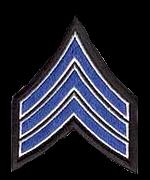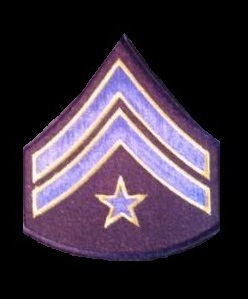SWORN RANKS OF THE SDPD
CHIEF OF POLICE: Represented by four gold stars on the uniform collar
EXECUTIVE ASSISTANT CHIEF: Represented by three gold stars each uniform collar
ASSISTANT CHIEF: Represented by two gold stars on the uniform collar
CAPTAIN: Represented by two gold bars on the uniform collar
LIEUTENANT: Represented by one gold bar on the uniform collar
SERGEANT: Represented by three blue chevrons on the uniform sleve
POLICE OFFICER III: No collar device, two blue chevrons on the uniform sleeve
DETECTIVE: Non uniformed, No collar device, two blue chevrons above a single star on the uniform sleeve
POLICE OFFICER II: No collar device, no chevron
POLICE OFFICER I: No collar device, no chevron
POLICE RECRUIT: No collar device, no chevron

OBSOLETE RANKS
AGENT:
CAPTAIN OF DETECTIVES: This rank was retired and un-retired several times in the departments history. Today, a police captain can be assigned to either a patrol or investigative command.
DEPUTY CHIEF OF POLICE: This rank was below an Assistant Chief (prior to 1993 the number two in command) and above the rank of Commander. This rank was represented by two gold stars on the collar. Under Chief Bob Burgreen the rank of Deputy Chief was replaced by Assistant Chief.
COMMANDER: The rank of Inspector was above Captain but below Deputy Chief. In that time period, the rank of Inspector was represented by one gold star on each side of the uniform collar. Under Chief Bob Burgreen the rank was eliminated.
CHIEF OF DETECTIVES: Captains grade with a specialized title. Traditionally represented by two stars at the bottom of the badge.
INSPECTOR: In the early 20th century this rank was above Detective but below Sergeant. Later, the rank of Inspector was aboe Captain but below Deputy Chief. In that time period, the rank of Inspector was represented by one gold star on each side of the uniform collar.
LIEUTENANT OF DETECTIVES: This rank was officially retired in the early 1990's. By that time it existed almost in name only as lieutenants often moved from investigations to patrol and back.
SERGEANT OF DETECTIVES: This rank first appeared around 1913. Today, the rank of Detective Sergeant exists in name only today; there is not an official civil service classification. To compensate sergeants for their additional duties and investigative expertise, they are paid 5% above the rate of a non Detective Sergeant.
INVESTIGATOR: Not much is known about this rank that existed from about 1917-1925. One theory is that at the time in order to become a detective one must first have been a Sergeant. It's possible this rank was created for line officers who would be assigned low grade cases.
ROUNDSMAN: This two stripe rank existed from about 1905-1915 when it was replaced by Corporals. The rank was above that of a patrolman but below a sergeant. As it waswritten the rank did have some supervisory duties.
CORPORAL: This two stripe rank existed from about 1915-1919 when it was abolished. The rank was above that of a patrolman but below Sergeant. As it was written the rank did have some supervisory duties.
RANGE MASTER: This official rank was created for Rodney S. Pease (SDPD 1930-1950), the founder of the police pistol range. Upon his retirement the rank was retired with him. Predecessors have occasionally referred to themselves as "Range Masters" however it is in title only, it is not a rank.
INSIDE MATRON: Police matrons were used in the women's jails and to deal with female delinquents from 1905 until the late 1950's when the rank was abolished.
OUTSIDE MATRON: Police matrons first appeared in the early 1910's and pre-dated Policewomen. They were uniformed and had full powers of arrest. The rank was abolished in 1917 and replaced by Policewomen.
COMMUNITY RELATIONS ASSISTANT TO THE CHIEF: This sworn position was created under Chief Bill Kolender and abolished through attrition under Chief Robert Burgreen.
COMMISSIONER: Until the early 20th century, the city of San Diego used a police commission to oversee appointments and policy implementation within the department.
SUPERINTENDENT: Phased out in the early 1940's. The title was for a civilian manager who oversaw the Bureau of Identification.
SURGEON: The rank of Police Surgeon existed from about 1910 until 1948. Their duties were to staff the police emergency hospital and render trauma care to those brought in by the police ambulance.
MOTORCYCLE OFFICER: The first motorcycle officer was hired in 1910 and worked in that capacity his entire career. Until 1945 it was possible for an patrolman to transfer to the motorcycle squad or to be hired directly into that rank. Today all officers assigned to the motor squad have worked as police officers in patrol prior to their motorcycle assignment.
POLICEWOMAN: The first policewoman was hired in 1917 and had full powers of arrest. The rank was abolished in 1930 due to budgetary issues. It was reinstated in 1954 however the new duties mandated women work only in the detective bureau in cases involving juveniles or sex crimes. The rank was abolished completely in 1974. Those with Policewoman badges were officially required to turn them in for badges that read Police Officer. Today there is no one active duty member of the San Diego Police Department authorized to wear a Policewoman's badge.
POLICEMAN: Conceived as a rank in 1930. The new title would replace that of Patrolman. For reasons unknown the concept was never approved.
PATROLMAN: This rank was the backbone of the police department from 1889 until it was abolished in 1974. From that point on all rank and file sworn officers were referred to as Police Officers. Those with Patrolman badges were officially required to turn them in however many were slow to do so and the order was not strictly enforced. Consequently, some uniformed officers wore patrolman badges well into the early 1990's. Today, the only way a sworn officer can officially wear a patrolman's badge is if his father once served in that rank and passed the badge down to him.
POLYGRAPH EXAMINER: A civilian position retitled as "Interview and Interrogation Specialists" in the early 21st century.
COMMUNITY SERVICE OFFICER: A civilian position created in 1978. In 2006 the classification was changed to "Police Service Officer." There have been attempts by the city to morph the classification into sub groups such as "African Service Officer, Indo Chinese Service Officer and even Filipino Service Officer" however only the classification of Police Service Officers exists under the civil service system.
CADET: Created in 1959, the rank was intended as a foot in the door for those who were too young to become sworn officers. The rank eventually joined with the Boy Scouts of America and made an unpaid position. The name of the rank was also changed to Explorer. In the 1990's the title was changed back to Cadet however it is still an unpaid position.
SPECIAL: Possibly created as far back as the 1800's, the first official documentation of a Special Police Officer in San Diego in 1908. Special officers were paid $1 a day and used only on an as needed basis. Today it is recognized that the special was the precursor to the Reserve Police Officer.
SECRET SERVICE:
MACHINIST:
MOUNTED OFFICER: The first mounted officer position was created in 1891. Officers were paid an additional $25 per month to maintain their horse. The last mounted officer to officially hold that rank was Alfred D. Schnepp in 1946.
CHAUFFER: The rank of Chauffeur first appeared in about 1915 and was used until approximately 1925. While some chauffeurs were used to drive unlicensed officers to calls for service, the majority of their time and duties was spent driving the police ambulance and or paddy wagon.
LIFEGUARD: From 1917 until 1947, the lifeguard service was part of the police department. Under Chief A.E. Jansen, they were moved to the Park and Recreation department in the years following WWII. Today, the lifeguard service is under the Fire Department.
METER MAID: Meter Maids took over parking enforcement from sworn officers in 1959. In 1972 the title was changed to Parking Controller. In the mid 1990'S the Parking Controllers were moved to the city Transportation Department. Later the name Parking Controller was changed to Parking Enforcement Officer.

NON SWORN RANKS OF THE SDPD
CRIMINALIST
DEPUTY DIRECTOR
LATENT PRINT EXAMINER
POLICE INVESTIGATIVE SERVICE OFFICER I & II
POLICE RECORDS SPECIALIST
POLICE PROPERTY AND EVIDENCE CLERK
SENIOR MANAGEMENT ANALYST
SUPERVISING CRIMINALIST
SUPERVISING LATENT PRINT EXAMINER